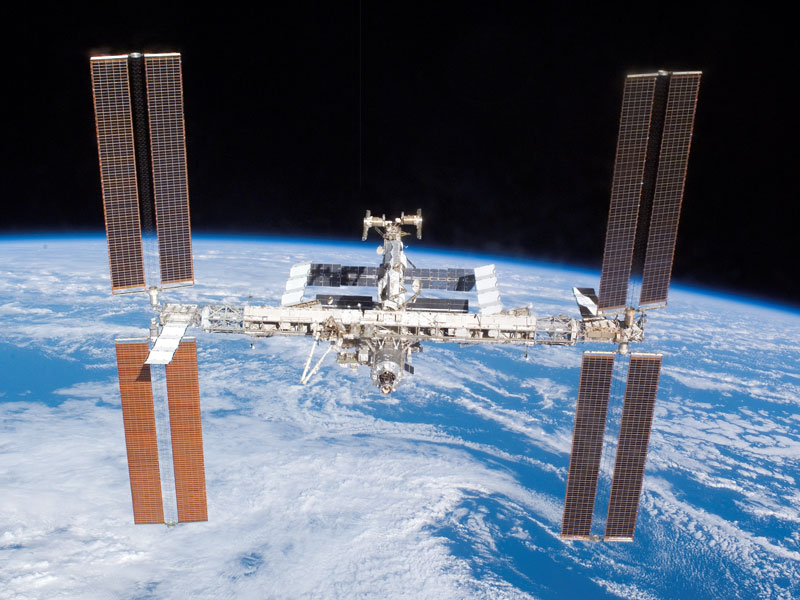

WHAT KIND OF EXPERIMENTS AND MAINTENANCE WORK DO THEY DO?
A DAY IN SPACE STATION UPDATE
Update your settings here, then reload the page to see it. This content is not available due to your privacy preferences. When a crew member isn't working on an experiment or two, they're doing maintenance work or preparing for extra-vehicular activity (EVA), which you might know better as spacewalking. Fridays - Astronauts work on personal projects and watch movies together as a crew.Sometime within the day, 5-6 days a week - Two-hour exercise (30 min.7:30 - midnight - Clean up and read the procedures for the next day, family time and time to look out the window to see the glorious views outside.6:30 - 7:30 PM - Dinner while watching the news taped by the ground crew from the day before and beamed up to the station.6 - 6:30 PM - Conference with ground crew to review that day's activities and discuss the next day.8 AM - 12 PM - Do experiments as assigned (Setting up, performing, tearing down experiments).7:30 - 8 AM - Breakfast and prep for work.straight from space) to run us through her typical day, and she gave us this sample schedule: We asked Coleman (whom you might remember as the astronaut who advised Sandra Bullock on what it's like to live in space. NASA astronaut Cady Coleman told us in an interview that they emphasize the non-political and just look for what they have in common with each other. Aboard the space station, however, crew members don't let politics bother them.

The former's already working with private space companies to develop manned vehicles that can launch from US soil by 2017. It's unclear how the recent friction between NASA and the Russian Space Agency will affect future missions.


He even likened the re-entry process into our atmosphere to "going over Niagara Falls in a barrel (that's on fire) followed by a high-speed crash." Good thing astronauts now only have to spend six hours per way in its cramped quarters, instead of two days like a few years ago. According to American astronaut Ron Garan, who lived on the ISS in 2011, Soyuz capsules are really small (it's a tight fit in there), so you can feel every bump of the crazy ride. There's a simple answer to that: They "hitch" rides (to and from Earth) aboard Russian Soyuz spacecraft to the tune of $71 million per person. You might be wondering how American astronauts get to the station without an operational space shuttle program. HOW DO AMERICAN ASTRONAUTS FLY TO THE ISS AND BACK? There can be as many as 10 people living on the station at a single time, or as few as two to three. These space agencies regularly send astronauts (and "cosmonauts," in the case of Russia) to the station for six-month expeditions, the first of which took off on October 31st, 2000. It's a huge project not owned just by a single country: NASA (USA), Roscosmos (Russia), JAXA (Japan), ESA (several European countries) and CSA (Canada) all pitched in to build it. The International Space Station is a habitable satellite that orbits the Earth at an altitude of 220 miles once every 90 minutes, which means the sun sets and rises for the crew 16 times a day. WHAT IS THE ISS AND WHEN DID PEOPLE START LIVING THERE? Want to hear more about life out there in zero-g? We do too, so we've dug deep into how astronauts and cosmonauts live each day in the ISS: from what kind of work they do to how they use the toilet. These hygiene amenities and prepackaged chow differ quite a bit from what we typically use: The shampoo and hand soap, for instance, are the special no-rinse kind, while some of the food comes in dehydrated powder form. People living on the ISS depend on the ground crew for most of their needs, and each resupply mission brings spare parts and hardware needed for repairs and experiments, packaged food and hygiene supplies. Luckily, crew members currently aboard the space station have enough food to last until March 2015 - more than enough, as some are scheduled to come home this month. The rocket was thankfully unmanned, but it was intended to ferry critical supplies to astronauts and cosmonauts aboard the International Space Station. In an unfortunate turn of events, Orbital Sciences' Antares rocket exploded a few seconds after launch last week.


 0 kommentar(er)
0 kommentar(er)
